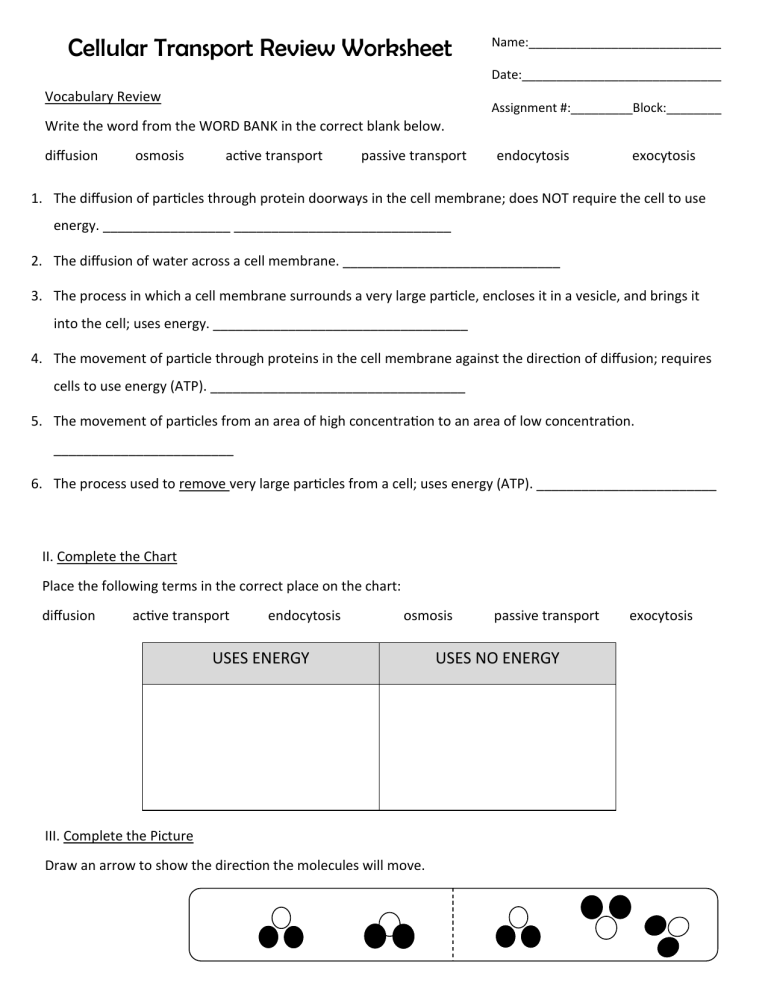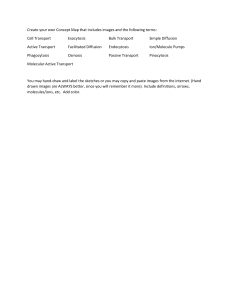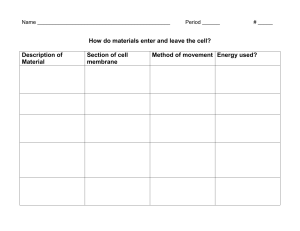
Cellular Transport Review Worksheet Name:____________________________ Date:_____________________________ Vocabulary Review Assignment #:_________Block:________ Write the word from the WORD BANK in the correct blank below. diffusion osmosis active transport passive transport endocytosis exocytosis 1. The diffusion of particles through protein doorways in the cell membrane; does NOT require the cell to use energy. _________________ _____________________________ 2. The diffusion of water across a cell membrane. _____________________________ 3. The process in which a cell membrane surrounds a very large particle, encloses it in a vesicle, and brings it into the cell; uses energy. __________________________________ 4. The movement of particle through proteins in the cell membrane against the direction of diffusion; requires cells to use energy (ATP). __________________________________ 5. The movement of particles from an area of high concentration to an area of low concentration. ________________________ 6. The process used to remove very large particles from a cell; uses energy (ATP). ________________________ II. Complete the Chart Place the following terms in the correct place on the chart: diffusion active transport endocytosis osmosis USES ENERGY III. Complete the Picture Draw an arrow to show the direction the molecules will move. passive transport USES NO ENERGY exocytosis IV. Fill in the Blanks Complete the sentences by filling in the blanks. 1. In diffusion, molecules move from areas of ____________ concentration to areas of ____________ concentration. 2. Diffusion continues until the concentration on both sides of the membrane is ________________. 3. Diffusion occurs __________________ in high temperatures. 4. Cells will shrink (known as plasmolysis) from loss of ____________________. 5. Sugars and amino acids are examples of molecules that (CIRCLE ONE) are or are not small enough to fit through the protein channels (doorways) in the membrane. 6. Active transport moves materials from areas of _____________ concentration to areas of ____________ concentration. 7. Endocytosis and exocytosis are methods of transport (for very large particles) that (CIRCLE ONE) require or do not require ATP (energy). V. Complete the Picture 2 Use arrows to indicate which direction water will move by osmosis. Then, circle whether the cell will shrink or swell (get bigger). Situation 1: Solution on the outside of the cell becomes high in salt and other substances. SHRINK or SWELL Situation 2: Solution on the outside is very high in water, low in salt. SHRINK or SWELL VI. Comic Relief! Draw a cartoon below that shows what happens to a cell when a person gets dehydrated. Include what happens to the cell’s environment, the cell itself and to the whole person.


